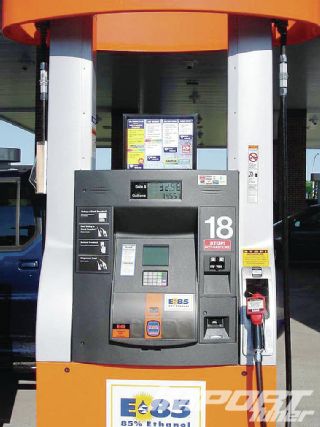 | E85 Fuel From 93 Octane - Question It
| E85 Fuel From 93 Octane - Question It
Amazing and unknown facts on Eric Hsu:
Fact No. 2
Although Eric’s owned his 2NR column of over three years, he confesses to us that he has yet to receive a complementary issue in the mail—better yet, read his own column at the local Barnes and Nobles. Sorry Eric, but the tight economy eliminates us offering any freebies, which includes gifting magazine copies for you!
Eric is SOL but nevertheless, he’s ready to answer your questions and pick his favorite tech questions for each installment of Question IT over the next few months. Got a good one? Send it to questionit@importtuner.com
E85 Drawbacks?
I’m trying to gain some more power out of my ’04 STI, which currently has a Raw Stage 2+ block, Blouch 20G turbo externally gated, and all supporting bolt-ons. I have researched E85 fuel and decided to make the switch from 93 octane. After consulting several tuning shops (P&L, IAG, Cobb, and MPS) I have picked up Injector Dynamics 1,000cc/min injectors with top-feed conversion fuel rails, Bosch regulator, Aeromotive 340-lph fuel pump, and some MPS fuel lines. I have been unable to find a definite answer to whether or not I will need a different fuel filter or if the OEM one will be sufficient. I have also heard mixed answers on when and how to switch back and forth between E85 and 93-octane fuel. Some say to switch every couple of tanks while being on empty to remove condensation and soot out of the lines, while others say to change fuel whenever needed if at all. Finding E85 isn’t a problem for me since there’s an abundance of stations within a 50-mile radius of where I drive. How often do you recommend switching between E85 and 93 (I’ll have maps on my Cobb AP for both) and are there other parts you would recommend that I get before I make the fuel switch?
-Andrew M.
York, PA
 |
E85 Fuel From 93 Octane - Question It
|
E85 Fuel From 93 Octane - Question It
You can use the factory fuel filter without any issues. It would be a good idea to change the filter soon after making the switch to E85 since it can actually clean and loosen particles and residues built up in the tank and lines over the years from gasoline. E85 from brand-name gas stations is going to be higher grade and cleaner. The only thing you need to worry about is fuel consistency since “E85” can contain anything between 70 and 85 percent ethanol and still be called E85. Making the assumption that the fuel is consistent can be an expensive mistake that might show itself in the form of a melted piston. Federal regulations do not require gas stations to inform the buyer of actual ethanol content since the fuel is really designed for flex fuel vehicles. To be safe with any mixture ratio of ethanol and unleaded, you can use a GM flex fuel sensor with a stand-alone ECU that can support the flex fuel sensor. Otherwise the only really safe way to switch between E85 and unleaded is to completely drain the fuel tank before switching back and forth. You can run a blend of E85 and ethanol for part throttle and cruise depending on your ECU’s close loop fueling capabilities, but for any kind of wide-open throttle usage, I recommend you completely drain the tank and make sure the ECU has the correct map loaded in it. Then again, there’s no real need to switch back and forth if you have regular access to E85. A detrimental amount of condensation building up in fuel tanks is just a theory and hasn’t really been proven. If you’re afraid of condensation, then you can keep the tank full as often as possible to prevent and minimize it. I’m not sure where your soot concern comes, but it sounds like an old wives’ tale. Once you drive the car retuned on E85, I sincerely doubt you’ll ever want to go back to 93-octane unleaded. It’s like crack for car enthusiasts!
Where’s the Research, Eric?
You may not (and probably won’t) choose to respond to this, but after reading issue after issue of negligent responses I feel the need to say something. It seems that in every issue there is some question directed to Mr. Eric Hsu that involves an uncommon car or a dollar amount for certain mods that Mr. Hsu just shoots down. Let’s take the Aug. ’11 issue for example: The WRX owner looking for an aftermarket turbo, intercooler, injectors, clutch, flywheel, wheels, BBK, sway bar, and whatever else, and the ’86 Toyota pickup looking to install the 2JZ. If you couldn’t get all of those mods for under $10K (and brand name too) then you might as well take your $10K and throw it at the first fat hooker you see on the corner. Let’s break this down in order of my choice parts:
Turbo: Brand name TD06 $1,300
FMIC kit: Perrin FMIC kit $1,447
Injectors: Five O Motorsports 750cc EV14’s or side feeds $333
Clutch and Flywheel: Ark twin disc and flywheel $1,700
Wheels and Tires: Rota G-Force rims and 275/40R18 Nitto NT555s $1,748
BBK: Wilwood kit with 13-inch rotors $900
Sway bars: Perrin front and rear setup $694
Tuner: Cobb AccessPort $695
Final Cost: $8,517, all prices include shipping so you have just under $1,500 to rent a fender roller and run to the Subaru dealer to replace all of the bolts and plastic pieces you break in the install process.
In regards to the Toyota pickup, I work at a shop that has done a lot of these swaps for two- and four-wheel-drive enthusiasts alike. For two-wheel drive, any do-it-yourselfer with an engine hoist and basic hand tools can do it. A four-wheel drive may be out of Mr. Sam Marchesi’s reach, as it requires a custom transmission bracket and sometimes a custom front driveshaft. The kit to mount a 2JZ and R154 in a two-wheel-drive Toyota pickup is $375 from BICPerformance.com with solid mounts and no firewall mods required. The engine bay is more than accommodating for the 1JZ or the 2JZ, a thick radiator, and an intercooler with a pair of slim fans sandwiched in there.
All I’m saying is that Mr. Hsu needs to quit preaching to the choir and actually write research-backed responses for all of the questions he chooses to publish.
-Max Hughs,
via importtuner.com
First off, the Wilwood BBK with 13-inch rotors is nowhere near $900—even at a warehouse distributor’s cost. If you’re talking about the 12-inch kit, then yes, they are about $950 on the web, but then we really aren’t talking about a “big” brake kit since the stock rotors are already 11.5 inches in diameter. The lowest price I could find the 13-inch Wilwood BBK was about $1,426. Secondly, the Ark twin disc and flywheel kit only works with Subaru six-speed transmissions. The ’02 WRX has the older five-speed transmission that uses a different flywheel, clutch, fork, and throwout bearing. I also happened to help Ark Design with designing the clutch slave cylinder plumbing and tested the clutch for them for two weeks. Perhaps you’re the one not doing the research.
 |
E85 Fuel From 93 Octane - Question It
|
E85 Fuel From 93 Octane - Question It
While it is true that I am pretty much an elitist when it comes to parts selection and generally recommend the higher-end brands, I will never recommend counterfeit parts. The turbo you mentioned is made in a Taiwan factory from some parts that are made in China; it is essentially a counterfeit Mitsubishi Heavy Industries turbo so I could never recommend it. Instead, I’d recommend the genuine MHI TD06-20G, which you can actually buy from Turbo-kits.com for $1,395. For an additional $95, you would be getting higher-quality OEM Mitsubishi quality. The Rota G-Force wheels are essentially counterfeit Advan RS wheels. So while you might be down to fake the funk, I’m not and I would never recommend anybody else to do so either. Don’t get me wrong: I’m not anti-Rota. I’m just anticounterfeit. I won’t say anything to anyone for rolling a Rota wheel of his or her own design.
Even if Matt (WRX owner) did get all the parts you mention for $8,500, what about the supporting parts? He mentioned he had $10K total, but it “included” the parts in your list. You’ll also need the supporting parts to go within that $10K budget, such as a fuel pump, downpipe, up-pipe, high-flow cat, cat-back exhaust, air filter, and a shock and spring or coilover setup. Then, what about the ECU mapping? Sure, you could use the generic maps downloaded off the web, but that would not be specifically for your car or engine either. The further the car deviates from stock, the more unsafe generic web-sourced ECU maps are. Even Cobb will tell you to visit an authorized Cobb tuning center or to purchase the software for a custom tune. To tune the car yourself, you’d need a wideband 02 sensor and an amp. Either way, I think you get the picture. That $10K probably won’t get Matt everything he’ll need, which is what I originally stated.
As far as the Toyota pickup is concerned, you probably got me on the 2JZ swap. The swap I saw was done about 10 years ago and the firewall was cut and modified to do it. If somebody makes a kit to drop in a 2JZ without cutting the firewall, I did not know about it. Sorry if I misled anybody, but a 2JZ in a Toyota truck? That is just a dumb swap if you consider the physics. A tall, long heavy engine in the front will ruin what little handling ability the Toyota truck has. Then, having zero weight over the rear-drive wheels is pointless. You might as well buy an El Camino and be done with it. Sure, I know people build different cars for different reasons, but a properly built turbo 22R would be just as fast in the quarter-mile on street tires.
Logic is the determining factor I use to shoot down what I consider to be useless or waste of money builds. If they don’t make sense, I shoot the build down. It needs to not only make sense from a monetary standpoint, but also from a complexity standpoint. Nobody loves an unfinished money pit for a car that takes up all of his or her time.
As for the shooting people down where there’s money mentioned, most people don’t realize what it costs to build a car properly. Just remember I’m not here trying to be an ass; it’s my job to let them in on reality. Jumping into any build or project with too small of a budget takes the fun out of everything. Hopefully I can show them a way where they can enjoy their car, since enjoying a car on the road is what it’s all about.
Pimp Slap
I own an S13 240SX currently running an SR20DET and an Integra GSR. I thought it would be OK to buy a few inexpensive parts off of eBay, but when the parts arrived I think Eric popped out of the box and smacked me in the mouth. I just want to apologize. Sorry, Eric. I will be using quality components from here on out!
-Vasilios Pentsas,
via importtuner.com
I’m glad you learned that cheap generic copy parts suck now rather than discovering the hard way (e.g. a broken tie rod while on the track). Sometimes you can get away with buying cheap copies, but usually people don’t. Why roll the dice every time you purchase a part? Even if 1 out of 10 cheap-ass copy parts work, there’s still a 10 percent chance you’re going to get that one part that does fail. The reality is that you rarely hear about the failures. Nobody wants to look like the cheap-ass idiot who bought the fake Chinese junk, but you’ll always hear about how awesome a fake Chinese part is when it doesn’t fail because the guy spent $20 on a blow-off valve. Trust me, there are loads of failures, and the parts that don’t fail generally, fail long before they are supposed to. The bottom line is that high-performance cars and parts live a hard life. If you want to cut costs, purchase something unimportant like a frying pan or an egg timer. It’s just plain stupid, dangerous, and a waste of money to be cheap on parts that live a hard life.
